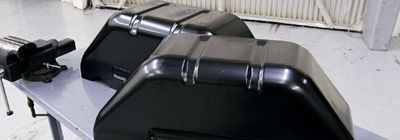
What's round, wide, and black all over? Give up? The rear tires you're trying to fit into your old truck's wheelwells. Doesn't work all that well, huh? Since most classic trucks were built with tall and narrow bias-ply tires in mind, it gets tough squeezing modern rubber into those small wheelwells. Unless you decide to run tires that'll fit in the stock wheelwells, adding wheel tubs is about the only fix. This has been done to countless cars and trucks over the years since "fat" tires first became available, but what if you're not really into the "tubbed" look that usually goes along with them? I like when a vehicle's stock sheetmetal looks like it came that way from the factory, as if nothing had been altered except for the commonplace barrellike wheel tubs that don't flow all that well with the rest of the stock tin. Depending on your level of handiness or budget, there are options.
Since I lack the second item, I take the down-and-dirty hands-on road that becomes very rewarding once you're on the other side. Custom work of any sort on a truck is tedious, time consuming, and at times-frustrating, but it should always be a learning experience, and custom metalwork is no exception. I had never tubbed any vehicle until I was faced with trying to stuff the 255/55/R18 Toyo tires under my '68 F-100's backside. The tires fit into the wheelwells, but not very well judging by the way they rubbed on the inside of each one, which didn't interfere with pushing it around the shop, but was definitely not going to work on the street.
Having just spent more than a few days last month raising the whole bed floor to clear the step notch in the chassis with great results, I had to figure out a way to widen the wheelwells that was on par with the rest of the bed modifications and would ultimately look as if the large presses and tooling at Ford had turned these pieces out long ago. Using a set of reproduction steel wheelwells from National Parts Depot (NPD), some careful slicing and dicing, and some electric glue from my Miller TIG welder, I achieved my goal. Read on for the details, and remember, it's only sheetmetal, and practice makes perfect!